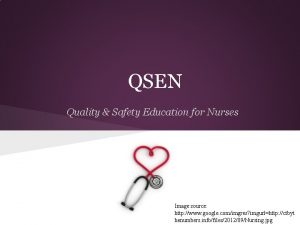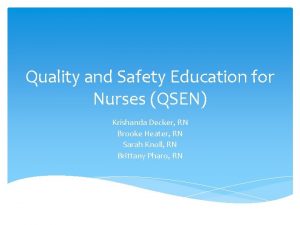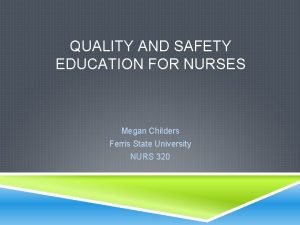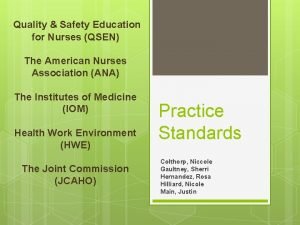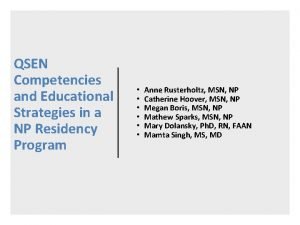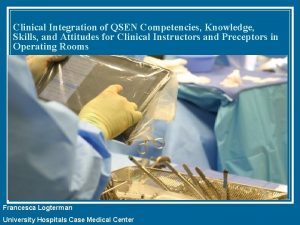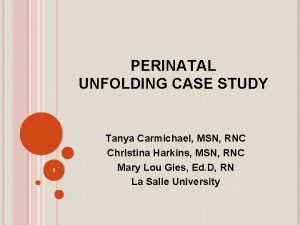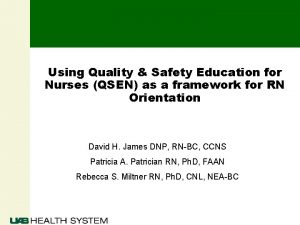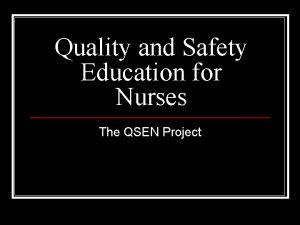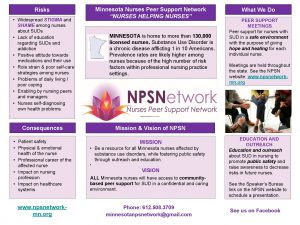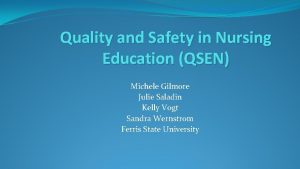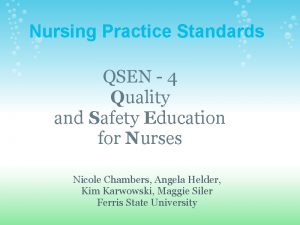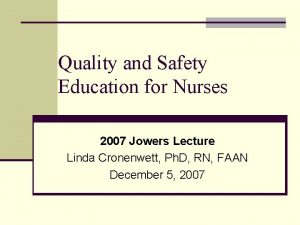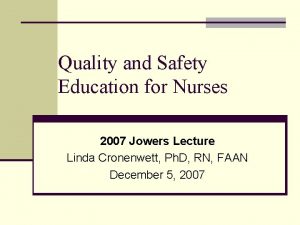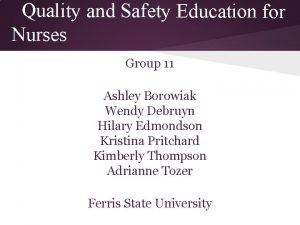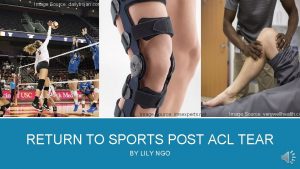QSEN Quality Safety Education for Nurses Image source























- Slides: 23

QSEN Quality & Safety Education for Nurses Image source: http: //www. google. com/imgres? imgurl=http: //ctbyt henumbers. info/files/2012/09/Nursing. jpg

Presented by: § § § Julie Ivey Angel Kinyon Courtney Olach Kimberly Reed Nichole Thurlow Image source: http: //www. google. com/imgres? imgurl=http: //ctbythe numbers. info/files/2012/09/Nursing. jp

What is QSEN? • • • QSEN stands for Quality and Safety Education for Nurses. The implementation of these practice standards consists of three phases. The purpose of QSEN is to prepare future nurses with the knowledge, skills and attitudes needed to improve the quality and safety of their practice("Qsen quality and, " 2012).

When was it Started? • • • It was started in October 2005 with phase I and phase II. Dr. Linda Cronenwett led the phase I project. There are 3 phases to the QSEN project (Brady, 2011).

The Three QSEN Phases • • • Phase I-(November 2005) Evaluate and enhance current curricula of nursing schools regarding quality and safety of care. Phase II-(April 2007) Continue progress of Phase I in addition to draft proposed knowledge, skills, and attitude targets for graduate level education. Fifteen pilot schools will also be implemented. Phase III- (February 2009) Develop the faculty expertise needed to teach the QSEN’s six competencies with attention to instilling the competencies in textbooks, licensing, accreditation and certification standards; and promote continued innovation in teaching the competencies ("QSEN quality and, " 2012).

Why Was QSEN Created? In 2003 the Institute of Medicine (IOM) challenged faculties in the health professions to implement fundamental changes in their curriculums to produce professionals who can function effectively in a reformed health care system focused on quality and safety (Barnsteiner & Disch, 2009).

Who Created QSEN? In response to the IOM challenge, the Quality and Safety Education for Nurses (QSEN) initiative formed to facilitate the implementation of the needed curricular changes in nursing education (Barnsteiner & Disch, 2009).

How is it funded? • • The Robert Wood Johnson Foundation is the sole source of financial support for QSEN. The Robert Wood Johnson Foundation is the largest philanthropic organization in the U. S that is committed to improving health and health care ("Qsen quality and, " 2012).

Six QSEN Competencies The six QSEN competencies: 1. Patient -Centered Care 2. Teamwork and Collaboration 3. Evidenced-Based Practice (EBP) 4. Quality Improvement (QI) 5. Safety 6. Informatics These competencies prepare future nurses to improve the quality and safety in their work (QSEN, 2012).

QSEN Model (RN e. D, 2011)

How are the Six Competencies Defined and Implemented? Patient-Centered Care • "Recognize the patient or designee as the source of control and full partner in providing compassionate and coordinated care based on respect for patient's preferences, values, and needs" (Quality and Safety Education for Nurses, 2012) Teamwork and Collaboration • "Integrate best current evidence with clinical expertise and patient/family preferences and values for delivery of optimal health care. " (Quality and Safety Education for Nurses, 2012)

Definitions Continued. . . Evidenced-Based Practice (EBP) • "Integrate best current evidence with clinical expertise and patient/family preferences and values for delivery of optimal health care" (Quality and Safety Education for Nurses, 2012) Quality Improvement (QI) • "Use data to monitor the outcomes of care processes and use improvement methods to design and test changes to continuously improve the quality and safety of health care systems. "(Quality and Safety Education for Nurses, 2012)

Definitions Continued. . . Safety • "Minimizes risk of harm to patients and providers through both system effectiveness and individual performance" "(Quality and Safety Education for Nurses, 2012) Informatic • "Use information and technology to communicate, manage knowledge, mitigate error, and support decision making"(Quality and Safety Education for Nurses, 2012)

What has QSEN Done for Nursing as a Profession? By revamping the curriculum and focus of prelicensure nursing programs, the QSEN initiative is constantly improving the nursing profession through the development of more competent nurses. The incorporation of the QSEN competencies and KSA's encourages the student nurses to be better prepared to continue the quality and safety improvement necessary in the ever-evolving field of healthcare (Cronenwett, Sherwood, & Gelmon, 2009).

Julie's Practice In my current practice area of ICU in the hospital, QSEN practice standards influence my nursing practice by providing knowledge to new nurses that will minimize risk of harm to patients and providers through both system effectiveness and individual performance. The safety standards provided will ensure safe quality patient care in intensive care units.

Angel's Practice QSEN impacts my future practice as a Psychiatric Mental Health Nurse Practitioner (PMHNP) directly as the education requirements are currently being revamped to incorporate the six QSEN competencies (Weber, Delaney, Mc. Coy, Snow, Scharf, & Brackley, 2012). This will better prepare me to be a competent PMHNP and ensure I will have a high quality and safe practice through my knowledge, skills, and attitudes.

Courtney's Practice In my hoped for practice area of wound/ostomy care, QSEN practice standards influence my nursing practice by helping to establish or further define safety standards that must be meet as well as providing resources to aid in the implementation of these safety standards. This allows wound/ostomy care professionals to provide the best patient centered care available.

Kimberly's Practice QSEN standards directly affect my practice as a nurse in the Emergency Department by influencing the performance standards of our hospital. We focus on providing excellent patient care and aim to be a national healthcare leader. QSEN allows us to focus on safety for both patients and healthcare workers in areas such as infection control, workplace violence, and effective treatment. Studies show that education and knowledge of effective recovery strategies in the emergency department can ultimately be used to develop interventions for reducing medical error and improving patient safety (Pub. Med, 2012).

Nichole's Practice standards influence nursing practice in my area of nursing in many ways. I work on a surgical floor that is fast pace with high acuity patients. As a nurse on the floor you are always delegating, collaborating, assessing situations, and ensuring your patients care is being delivered in the most ethical and safe way. QSEN practice influences nursing practice by preparing future nurses to have the knowledge, skills, and attitudes to improve the quality and safety of the healthcare systems (Cronenwett, 2012).

Nichole Continued There are five core areas that are hoped nurses will maintain proficiency. These areas are patientcentered care, interdisciplinary teams, evidence based practice, quality improvement, and information technology (Hunt, 2012). QSEN helps positively impact patient outcomes. We as nurses can help integrate this into our current practice and serve as role models for future nurses and new nurses (Barnsteiner, 2012).

Conclusion QSEN helps to better prepare future and current nurses in providing quality patient safety and care. The six competencies set a concrete model to exemplify important aspects of nursing care. Facilities are able to incorporate the QSEN standards into their own policies and procedures to provide a parallel level of care in accordance to national standards.

References American association of College of Nursing (2009). UNC school of nursing joins AACN in helping nursing faculty improve quality and safety education. Retrieved from http: //www. aacn. nche. edu/news/articles/2009/qsen Barnsteiner, J. , Disch, J. (2009). Defining patient safety and quality care: QSEN competencies. Retrieved from http: //www. aacn. org: 88/WD/NTI 2009/nti_cd/data/papers/main/43292. pdf Barnsteiner, J. (2012). About QSEN. Retreived from http: //www. aacn. nche. edu Brady, D. S. (2011). Using quality and safety education for nurses (QSEN) as a pedagogical structure for course redesign and content. International Journal of Nursing Education Scholarship 8(5). Cronenwett, L. (2012). About QSEN. Retrieved from http: //www. qsen. org Cronenwett, L. , Sherwood, G. , & Gelmon, S. (2009). Improving quality and safety education: The QSEN learning collaborative. Nursing Outlook, 57(6): 304 -312. doi: 10. 1016/j. outlook. 2009. 004

References Henneman, E. A. , Blank, F. S. , Gawlinski, A. , Henneman, P. L. (2006). Strategies used by nurses to recover medical errors in an academic emergency department setting. Applied Nursing Research: ANR, 19 (2): 70 -77. Hunt, D. (2012). Nursing made incredibly easy: QSEN competencies: A bridge to practice. doi: 10. 1097/01. ONE. 0000418040. 92006. 70 RN e. D. (2011). QSEN, dedicated education units, and driving change. Retrieved from http: //www. nurseacademia. com/2011/09/qsen-dedicated-education-units-and. html Qsen quality and safety education for nurses. (2012). Retrieved from http: //www. qsen. org/overview. php Weber, M. , Delaney, K. R. , Mc. Coy, K. T. , Snow, D. , Scharf, M. , & Brackley, M. H. (2012). Quality and safety graduate competencies in psychiatric mental health nurse practitioner education. Archives Of Psychiatric Nursing, 26(5): 350 -357. doi: 10. 1016/j. apnu. 2012. 06. 005
 Quality and safety education for nurses
Quality and safety education for nurses Quality and safety education for nurses (qsen)
Quality and safety education for nurses (qsen) Megan childers
Megan childers Quality and safety education for nurses
Quality and safety education for nurses What is qsen
What is qsen Qsen competency safety
Qsen competency safety Qsen competencies
Qsen competencies Qsen competencies
Qsen competencies Qsen competencies
Qsen competencies Qsen
Qsen Qsen competencies examples
Qsen competencies examples Qsen simulation rubric
Qsen simulation rubric Qsen teamwork and collaboration
Qsen teamwork and collaboration Qsen unfolding case studies
Qsen unfolding case studies Quality control and quality assurance
Quality control and quality assurance Plan quality management pmp
Plan quality management pmp What are quality standards in project management
What are quality standards in project management Process of nursing audit
Process of nursing audit Quality improvement vs quality assurance
Quality improvement vs quality assurance Concepts of quality
Concepts of quality Quality gurus meaning
Quality gurus meaning Quality is free: the art of making quality certain
Quality is free: the art of making quality certain Old quality vs new quality
Old quality vs new quality Kontinuitetshantering i praktiken
Kontinuitetshantering i praktiken
